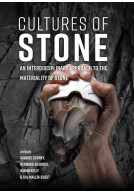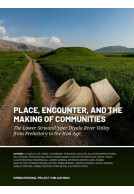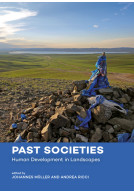Hortfunde der Spätbronze- und Früheisenzeit (Paperback)
Ein prozesslogischer Paradigmawechsel
Imprint: Sidestone Press
Pages: 210
Illustrations: 10fc/43bw
ISBN: 9789464280067
Published: 5th June 2021
Script Academic & Professional
Pages: 210
Illustrations: 10fc/43bw
ISBN: 9789464280067
Published: 5th June 2021
Script Academic & Professional
You'll be £40.00 closer to your next £10.00 credit when you purchase Hortfunde der Spätbronze- und Früheisenzeit. What's this?
+£4.99 UK Delivery or free UK delivery if order is over £40
(click here for international delivery rates)
Need a currency converter? Check XE.com for live rates
(click here for international delivery rates)
Need a currency converter? Check XE.com for live rates
In dieser Dissertation hat José Eduardo M. de Medeiros einen neuen theoretischen Ansatz mit der Untersuchung konkreter Probleme in der Bronze- und Eisenzeitforschung Mitteleuropas in Einklang gebracht. Das ursprüngliche Ziel war die Untersuchung der Schmuckhorte der Spätbronzezeit in Frankreich. Aber eine anfängliche Beschäftigung mit der Literatur zu den Hortfunden der Spätbronze- und Früheisenzeit führte zu der Einsicht, dass die Grundlagen prähistorischer Interpretation einer kritischen Revision bedurften.
Die angebotene Reflexion ist eng mit einer soziologischen Kulturtheorie verknüpft, die eine kritische Sicht darauf miteinbezieht, wie Menschen Objekte und Ereignisse in der Welt erklären. Es gibt einen revolutionären Wechsel zwischen vormodernen (handlungs- und substanzlogischen) und modernen (prozessualen) Erklärungen, und es war Medeiros' Aufgabe, die Folgen dieses Paradigmenwechsels für die archäologische Forschung zu verstehen.
Da diese Einsichten zu einer Relativierung der Niederlegungsabsichten als heuristisches Werkzeug führen und die Niederlegungsabsicht weiterhin als ein wichtiges Instrument für die Kategorisierung von Hortfunden dient, handelt es sich um Konsequenzen für die archäologische Interpretation im Allgemeinen und für die Deutung der Hortfunde der Spätbronze- und Früheisenzeit im Speziellen.
Die Arbeit zeigt, dass Schmuck-, Gefäß- und Waffenhorte verschiedene Arten von Deponierungen darstellen und dass, wenn diese Depots im religiösen Kontext der Zeit betrachtet werden, Schmuck und Gefäße die gleiche Bedeutung wie Waffen tragen. Dies steht im Widerspruch zu einer gängigen Auffassung der Spätbronze- und Früheisenzeit, welche die Krieger und ihre Waffen in den Vordergrund stellt.
Der Autor zeigt, dass dies eine kulturell konstruierte, „männliche“ Voreingenommenheit ist, die psychologische und soziologische Ursachen hat. Schließlich bietet dieses Buch einen rekonstruktiven Ansatz an, der die kulturelle Bedeutung der Schmuckhorte aufklärt.
English abstract
Throughout his Ph.D. Thesis, José Eduardo M. de Medeiros has balanced a deeply theoretical approach with the study of concrete problems within Central European Bronze and Iron Age Archaeology. The original objective of his thesis was the investigation of Late Bronze Age jewellery hoards in France. But an initial examination of the literature on the hoards of the Late Bronze Age and Early Iron Age led to the insight that the foundations of prehistoric interpretation required a deeper critical revision.
The proposed reflection is closely linked to a sociological theory of culture that entails a critical view of how human beings explain objects and events in the world. According to this view, there is a marked revolutionary change between "pre-modern" (subject logic) and "modern" (processual logic) explanations, and it has been Medeiros’s work to understand the ramifications of this paradigm shift for archaeological investigation. Essentially, this theoretical reflection questions attempts to explain a fact through recourse to the subjective intention or plan behind the fact. Consequently, these insights lead to a relativization of the subjective intention as a tool for interpretation of archaeological remains.
Such a position poses serious consequences for archaeological theories in general, and for the interpretations of the hoarding phenomenon of the Late Bronze and Early Iron Age in particular. The archaeological category of hoards is currently defined as an intentional selection of objects for unknown reasons. Nevertheless, the underlying intention is a highly-important instrument for the classification of the hoard finds as being either profane and/or ritual forms of deposition. Thus, an over reliance on the intentions behind an act clearly contrasts with the negative definition of that category.
This work shows that jewellery, vessels and weapons constitute different kinds of depositions (a.k.a. hoards), and that in addition, when these depositions are viewed in the religious context of the period, jewellery and vessels carry the same importance as weapons. This is contrary to the more common view that emphasizes warriors and their weapons, which the author demonstrates to be a male bias having psychological and sociological foundations. Finally, this book offers a reconstructive approach that clarifies the cultural significance of the jewellery hoards
Other titles in Sidestone Press...















